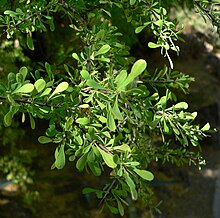Condalia
| Condalia | |
|---|---|

| |
| C. globosa | |
| Scientific classification | |
| Kingdom: | Plantae |
| Clade: | Tracheophytes |
| Clade: | Angiosperms |
| Clade: | Eudicots |
| Clade: | Rosids |
| Order: | Rosales |
| Family: | Rhamnaceae |
| Tribe: | Rhamneae |
| Genus: | Condalia Cav. |
| Species | |
|
See text | |
| Synonyms | |
Condalia is a genus of spiny shrubs in the tribe Rhamneae of the buckthorn family, Rhamnaceae.[1] It was named for Antonio Condal, an 18th century Spanish physician.[2] Members of the genus are native to tropical and subtropical deserts and xeric shrublands in North and South America. The ranges of each species vary considerably; some are confined to only a few square miles, while others can be found on an area up to 1,000 sq mi (2,600 km2).[3]
Common names[edit]
Condalia species are often referred to as bluewood, purple haw, logwood,[4] or snakewood in English. Some southern hemisphere species are known as "piquillín" or "yuna". The name snakewood is broadly used and does not indicate any particular species.
Taxonomy[edit]
Research performed on the members of Condalia usually concerns only the species native to North or South America; taxonomy is determined for only one group of species. As a result, a consensus has not been reached regarding the composition of the genus.
Uses[edit]
The amount of research conducted on the economic and medical uses of Condalia species is small. However, biochemical features of this genus are currently being studied.[5]
The fruit of Condalia hookeri are edible, consumed by birds, and can be made into jelly.[6]
Species[edit]
- Condalia buxifolia Reissek
- Condalia correllii M.C.Johnst. – Correll's snakewood
- Condalia ericoides (A.Gray) M.C.Johnst. – javelina bush
- Condalia globosa I.M.Johnst. – bitter snakewood (Southwestern United States, northwestern Mexico)
- Condalia hookeri M.C.Johnst. – Brazilian bluewood
- Condalia mexicana Schltdl. - Mexican bluewood
- Condalia microphylla Cav. – piquillín (Argentina)
- Condalia spathulata A.Gray – knifeleaf condalia
- Condalia velutina I.M.Johnst.
- Condalia viridis I.M.Johnst. – green snakewood
- Condalia warnockii M.C.Johnst. – warnock snakewood
- Condalia weberbaeuri Perkins – yana yana[7][8]
Formerly placed here[edit]
- Ziziphus obtusifolia (Hook. ex Torr. & A.Gray) A.Gray (as C. lycioides (A.Gray) Weberb.)[9]
References[edit]
- ^ a b "Genus: Condalia Cav". Germplasm Information Resources Network. United States Department of Agriculture. 2007-10-05. Archived from the original on 2011-06-06. Retrieved 2010-01-25.
- ^ Vines, Robert A. (1984). Trees of Central Texas. University of Texas Press. p. 277. ISBN 978-0-292-78058-3.
- ^ Cabrera, A. L. (1965–1970) "Flora de la provincia de Buenos Aires", Buenos Aires, Argentina.
- ^ Grandtner, Miroslav M. (2005). Elsevier's Dictionary of Trees: With Names in Latin, English, French, Spanish and Other Languages. Vol. 1. Elsevier. p. 245. ISBN 978-0-444-51784-5.
- ^ Frontera, M; Tomás, MA; Diez, A; Watson, C & Mulet, C. (2000) "Phytochemical Study of Condalia microphylla Cav.", INIQO, Departamento de Química, Universidad Nacional del Sur, Argentina.
- ^ Little, Elbert L. (1980). The Audubon Society Field Guide to North American Trees: Eastern Region. New York: Knopf. p. 593. ISBN 0-394-50760-6.
- ^ "Condalia Cav". TROPICOS. Missouri Botanical Garden. Retrieved 2009-09-24.
- ^ "Condalia". Integrated Taxonomic Information System. Retrieved 2010-01-25.
- ^ "GRIN Species Records of Condalia". Germplasm Information Resources Network. United States Department of Agriculture. Archived from the original on 2000-06-03. Retrieved 2010-10-15.
